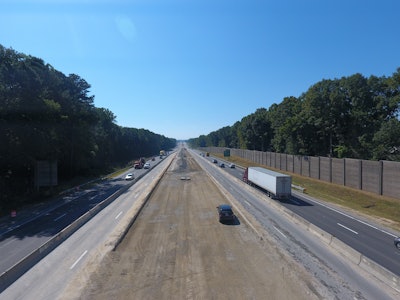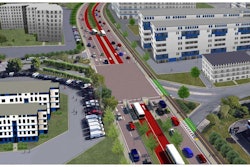
As North Carolinians hit the road for their vacations this summer, S.T. Wooten was making major progress on its 13-mile highway widening project on I-40 between Raleigh and Clayton. The completion of eight traffic shifts this past spring helped crews transition into the next phase of the $412 million job and prepare for significant grading and paving work set to take place through the fall.
The I-40 project, which commenced in 2018, includes the addition of two new lanes in each direction, which will help bring much need improvements to traffic conditions on the interstate. Crews are managing construction of 15 new or revamped bridges as part of the project. Upgrades will also include the installation of two diverging diamond interchanges (DDIs).
Design and Build
The I-40 project has been divided into six separate (but connected) construction areas to help crews tackle the expansive stretch with different activities happening in each area. In one section, crews are building the inside lanes first and pushing traffic to the outside lanes during construction. Other sections have the opposite design with construction happening in the outside lanes first.
Breaking things up into different construction areas helps the team manage different activities and keep the high volume of traffic flowing through the area. Understanding how each section fits together allows project managers to be strategic with planning and schedules. If there is a delay in one area, crews can shift priorities and focus on different objectives to keep things moving forward.
Getting Around the Traffic
One of the greatest challenges for crews on I-40 has been dealing with the traffic volume, which also impacts work schedules because there are strict hauling and lane closure restrictions. There is a lot of paving that must be done at night to accommodate restrictions and to avoid problems with hauling trucks getting stuck in traffic. One advantage S.T. Wooten has to help alleviate some of the issues is two asphalt plants right beside the work zone in the towns of Garner and Clayton for easy access.
Crews have utilized a temporary access ramp beside the Garner plant that runs from a closed bridge to help bypass traffic and haul asphalt right down into the median. A temporary road built adjacent to the plant provides access to the outside shoulder in the westbound direction. This system will save the team from having to haul approximately 24,500 loads of asphalt in traffic during the project.
At the Clayton plant, the team will be using a materials conveyer that will also allow crews to deliver loads directly to the median and bypass traffic. This conveyor is expected to help save an additional 7,600 loads from being hauled in traffic. The conveyor is expected to be installed in late 2022 or early 2023.
Safety First
S.T. Wooten has worked with the North Carolina Department of Transportation (NCDOT) to implement several practical safety measures for the estimated 100,000 vehicles that can pass through the I-40 stretch each day. The work zone has been equipped with intermittent speed limit reductions projected by electronic display in sections to help protect both construction crews and the traveling public. The median has also been fitted with construction entrances and warning systems to help inform drivers about the construction traffic flow exiting the median.
Additionally, the I-40 project is part of an automated work zone which further assists in traffic management and safety. Crews have set up sensors along the stretch to get data on road conditions surrounding the work zone and provide updates to the public as well as let drivers know when to consider taking alternative routes. Details on traffic issues and conditions are also routed to the NCDOT Statewide Operations Center where they can be distributed to the wider community.
Crew members are mostly working behind portable concrete barriers. While there have been accidents in the work zone, the barriers have helped to keep workers safe with no injuries on the job so far.
The Right Mix
For the I-40 highway expansion, S.T. Wooten is extending four-lane sections to eight lanes and six-lane sections to ten lanes. Existing lanes will receive 9.5-in. asphalt overlay on top of existing concrete. For new lanes, crews are crushing concrete from the old shoulders and recycling it as aggregate subgrade. The base will consist of a 12-in. layer of type 1 stone for the aggregate subgrade and 8-in. of ABC. On top of the stone will be a 13.5-in. asphalt structure that consist of multiple layers of base, binder and surface.
Crews are using Cat 1055 paver with Trimble 3D grade control systems to ensure efficiency and accuracy in the paving process. These systems help operators handle complex transitions, changing cross slopes and super elevated curves with precision. Additionally, the systems help with rideability, making for a higher quality ride throughout the project.
Two Diverging Diamonds
While original project plans only called for one DDI, the NCDOT has added a second to the I-40 project scope. A DDI allows two directions of traffic – guided by traffic signals, pavement markings, signs and concrete barriers – to cross over each other at traffic signals to get through the interchange.
The DDI design is newer in North Carolina, but it has proven successful in allowing drivers to come through an intersection smoother and safer. These will be the second and third DDIs that S.T. Wooten has constructed, having previously helped the state build its second-ever DDI near the coastal region of the state.
Another notable structure that crews have already built is a new flyover bridge at the I-440 interchange with I-40 that will help accommodate the wider eastbound lanes. The flyover bridge was completed in December 2020 and signaled a major visible milestone in the project’s progress for the public.
A Multitasking Endeavor
As crews continue to build momentum with work on I-40, S.T. Wooten is also busy with an expansive, $442 million project on a busy 18-mile stretch of I-95 just down the road near Fayetteville. The project shares many of the same characteristics and challenges as I-40 with objectives to widen the highway to alleviate traffic congestion and help bring the stretch up to modern engineering standards.
The I-95 project will see two new lanes added in both directions of the interstate, bringing it to eight total lanes between exits 55 and 72 with much of these upgrades completed by mid 2024. A total of 15 bridges are planned for construction or replacement as part of the project. A new ramp will be added to connect I-95 North to NC-295 South along with the installation of roundabouts to eliminate stop conditions at some interchanges.
S.T. Wooten leaders and crew members involved with both projects helping ensure efficiency in construction activities happening across I-40 and I-95 simultaneously. Teams have been in constant coordination, sharing insights and lessons learned for improvement. Crews are also rotating schedules for day and night work to help them stay fresh.
Experience is another supporting factor in this work as S.T. Wooten and the NCDOT have teamed up on many state road construction projects. The teams understand that plans can change drastically in any given day. Close communication helps everyone stay on track and make the right adjustments along the way.
In For the Long Haul
Crews have faced their obstacles on the I-40 job, just as they always do with projects this lengthy and expansive. Bad weather, pandemic challenges and other factors outside the team’s control have all thrown wrenches into plans at times. Being able to communicate and troubleshoot quickly has helped crews keep momentum.
The crews have embraced the challenges and their commitment will remain a major factor as work progresses toward the 2024 target deadline. In total, around 400 employees spanning every division of S.T. Wooten will have put their signature on this project. When all is said and done, they can be proud knowing their labor has had a great impact on the growing Raleigh area.
Matt Davis is project manager at S.T. Wooten.



















